How We Promoted Our Digital-Only Covers Album
Disclosure: This post may contain affiliate links, meaning I get a commission if you decide to make a purchase through my links, at no cost to you.
Matt Mancid and I just released an album of 80s covers that we’ve worked on since 2013.
As much as we would’ve loved pressing CDs or even vinyl, paying the rights for 1000 CDs doubles the cost. We would’ve absolutely, positively lost money.
So we released it digitally in two flavors: a 12-track standard edition and a 36-track deluxe edition. The latter is a Bandcamp exclusive.
In retrospect, digital-only was the way to go. The deluxe edition is outselling the standard by an 8 to 1 ratio, and the only physical format it would fit on is a USB key. My previous USB key release was a nightmare, with drives spontaneously corrupting after a year.
We could’ve just promoted the release to our existing fanbases, pocketed $600 each, and moved on.
Instead we focused on getting the album heard by as many people as possible. Every Bandcamp sale was an opportunity to reach more listeners.
I’m going to break down the campaign from start to finish.
This post-game analysis is extremely helpful, and I probably wouldn’t bother if you weren’t around to read it, so thank you!
The Pre-Release Campaign
The vast majority of sales occurred before release day as Bandcamp pre-orders. As a bonus, I included the eight demos I provided to Matt.
The plan was to remove those demos on release day, but then I realized that buyers wouldn’t be able to stream them from the Bandcamp app. For better or worse, those demos are now a permanent part of the deluxe edition.
I announced the album to my email list and on socials with a (true) story:
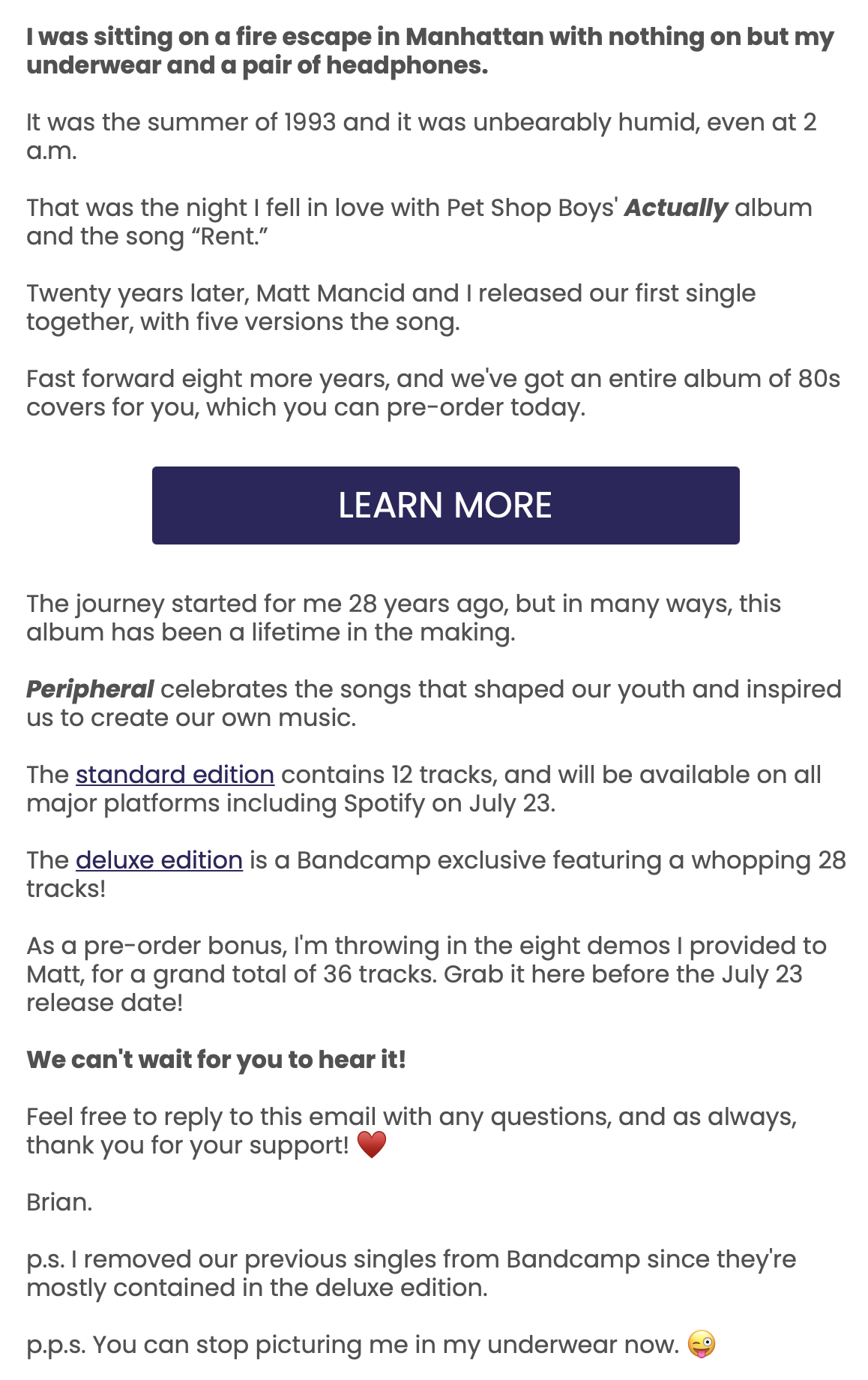
I thought my presale ad was pretty clever. It was a carousel of album art featuring the tracks we covered, asking what they all have in common (answer: we covered songs from all of them).
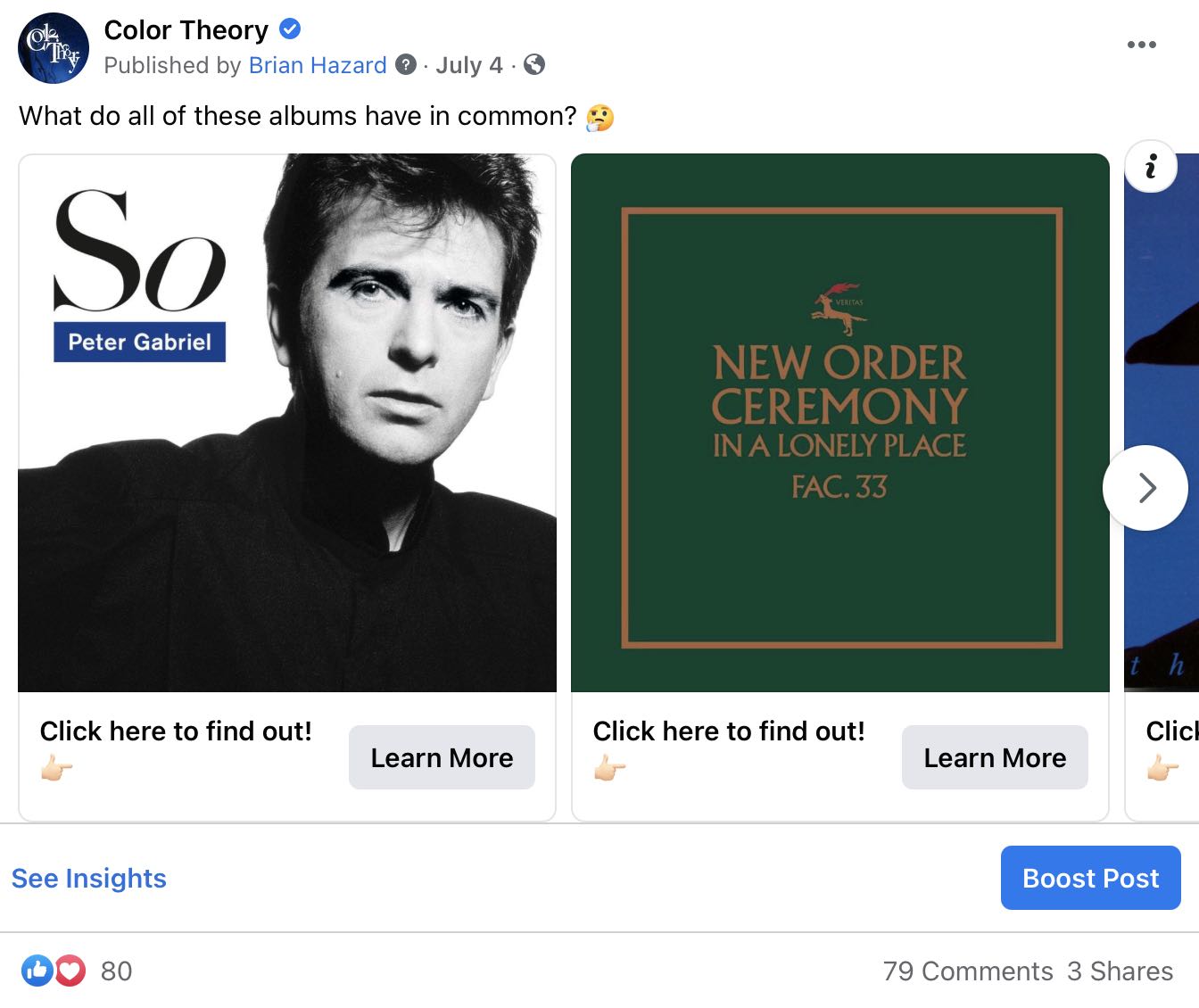
I ran the ad in a traffic campaign with the following targeting:
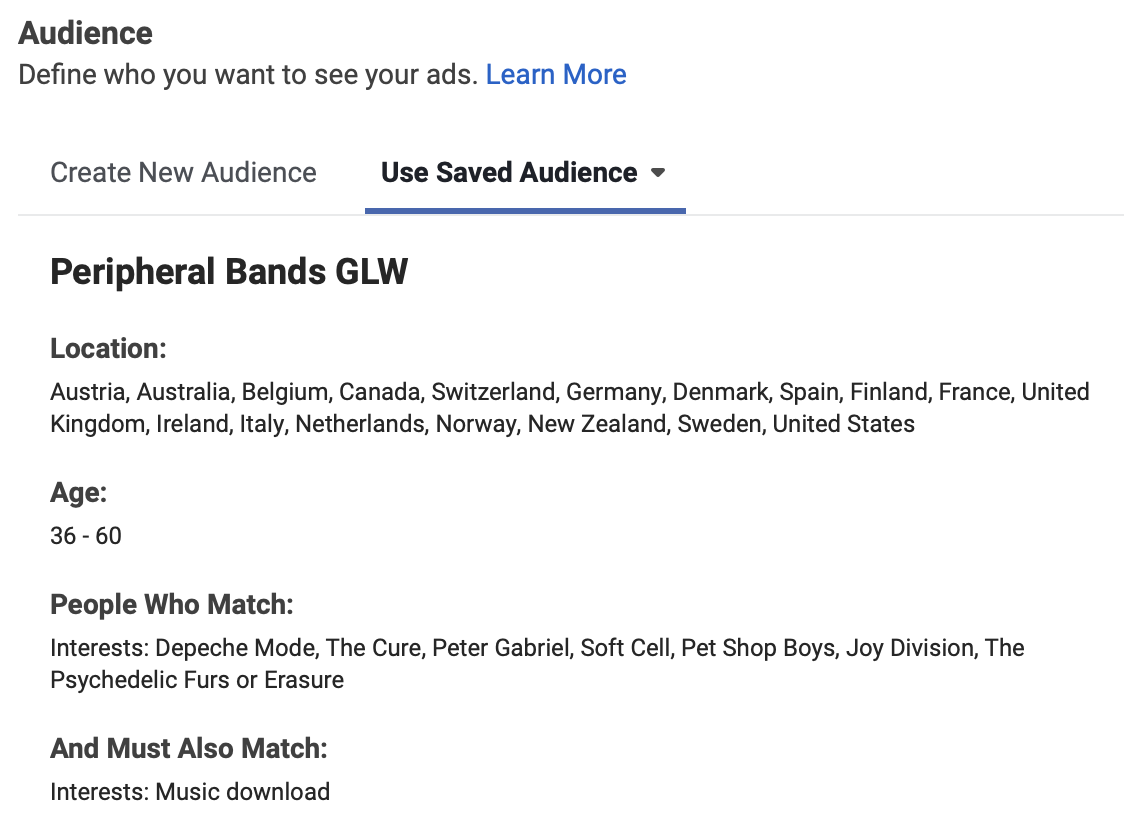
I also ran ads on my announcement post but pulled the plug at $6 per landing page view!

“Peripheral Cold” is the carousel ad, and “Peripheral GLW” is the announcement post. The “GLW” stands for “Green Light Warmth,” hitting audiences who previously engaged with me from the same countries as the cold traffic campaign.
In total, $140 of ad spend produced 1608 clicks to Bandcamp and a solid number of comments and likes. I don’t know how many sales those clicks generated, since Bandcamp doesn’t support Facebook’s pixel.
In fact, between Bandcamp’s lack of pixel support and their 15% fee, I almost ended up taking pre-orders on my own site. In the end, I decided that fans’ comfort, trust, and familiarity with Bandcamp, plus the added discoverability, outweighed the negatives.
In the three weeks before release day, I followed up with four additional emails:
- Explaining why the release was digital-only
- Pointing out how the color scheme of the singles matched the cover art of the original songs
- Announcing that the focus track was live on YouTube as a sneak peek
- Letting subscribers know it was their last chance to pre-order
To be clear, it wasn’t all Peripheral, all the time. I sent out a couple unrelated emails as well.
The Focus Track Campaign
We had already released six of the dozen tracks as singles over the past eight years, so those weren’t candidates for Spotify editorial pitching.
We opted to make our Depeche Mode cover the focus track, which is pretty much the center of the bullseye in 80s synthpop circles. Granted, the song (“The Sun and The Rainfall”) is pretty obscure, as are most of our other selections.
I treated the focus track promotion as I would any single release, starting with hiring Walker Dunn to create a Spotify canvas based on Depeche Mode’s album art, which he repurposed as a YouTube visualizer.
Running down my entire single release checklist is beyond the scope of this article, but could be a great subject for a future one! What do you think?
As previously mentioned, I released the focus track on YouTube and SoundCloud a couple of days early to help build momentum going into release day.
The Post-Release Campaign
When the big day came, I released the pre-order on Bandcamp (“this is not a drill”), leaned back, and let out a long sigh to commemorate eight years of disciplined work finally coming to fruition.
Then I put on my big boy pants and got to work!
There were email and social media announcements to make, Spotify playlists and bio to update, outlets to pitch, and most importantly, ads to turn on.
If ToneDen is to be believed, 99% of my Smart Link visits came from Facebook:
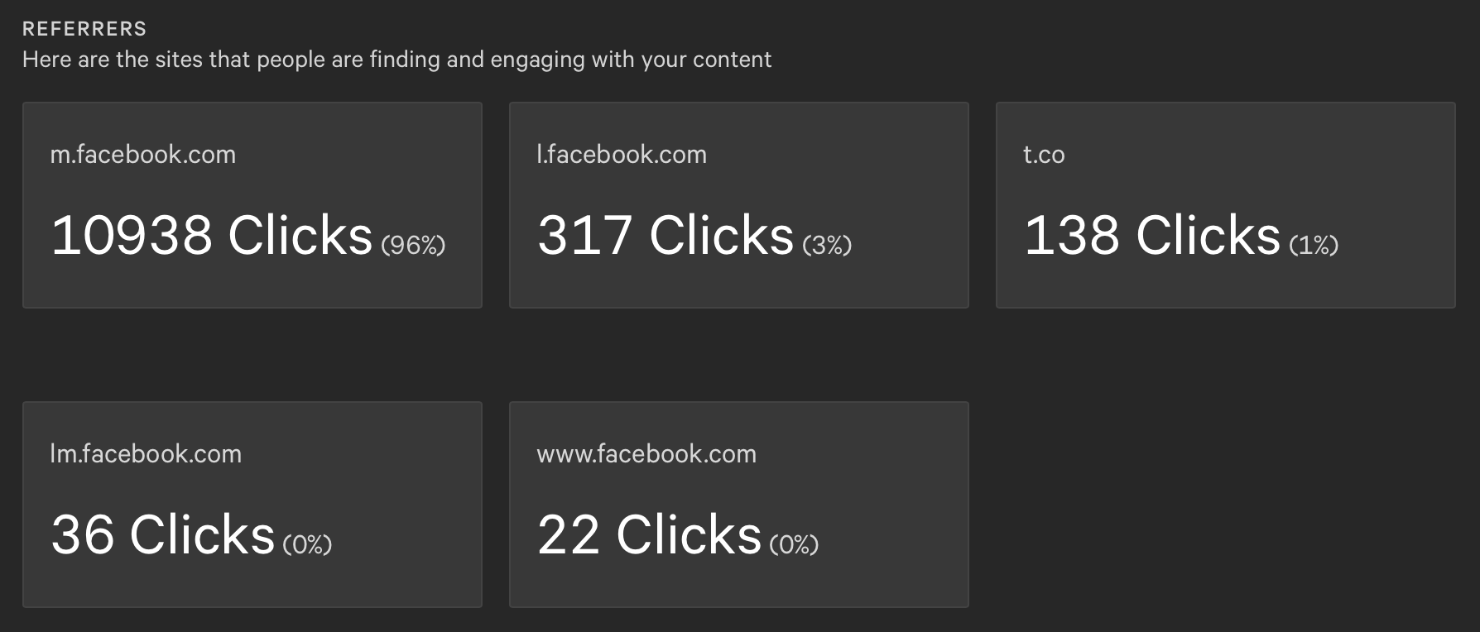
Before I break down the ad campaign, let’s run through the remainder of my noteworthy efforts, and a promising idea that never played out.
About that, I made an offer to a major outlet in the genre that shall go unnamed. If they would send out an email to their subscribers to announce our release, I would provide a unique discount code and kick them back a couple of bucks per sale.
It’s a win/win, right? Unfortunately, I never heard back. Maybe next time.
I sent out two additional emails over the following week:
- Explaining why we covered Fury in the Slaughterhouse, a band I had never heard of (they’re big in Germany, Matt’s home country)
- Asking fans to check out a Spotify playlist consisting of our covers back-to-back with the originals. I sent the same message out as an update to my 5K Bandcamp followers a few days later.
3. Announcing that I’d uploaded what appeared to be the fan favorite track on YouTube
Again, there were a couple of unrelated emails thrown in the mix (an AMV of my song “Juggernaut” and a new episode of Synthwave Top 10).
Finally, nearly a month after release, I tweeted out download codes for the standard edition. While I hate to devalue our work, the engagement (98 link clicks) was worth it.

Alright, about that ad campaign.
I created six videos featuring the original album art from the songs we covered plus an overlay from the Motionleap app on my iPhone, just to add some movement.
I figured I’d catch potential fans’ eyes with familiar album art, they’d click to listen, and that would seal the deal.
While that was true to a minor degree, I also included a page post that ended up consuming most of the budget:
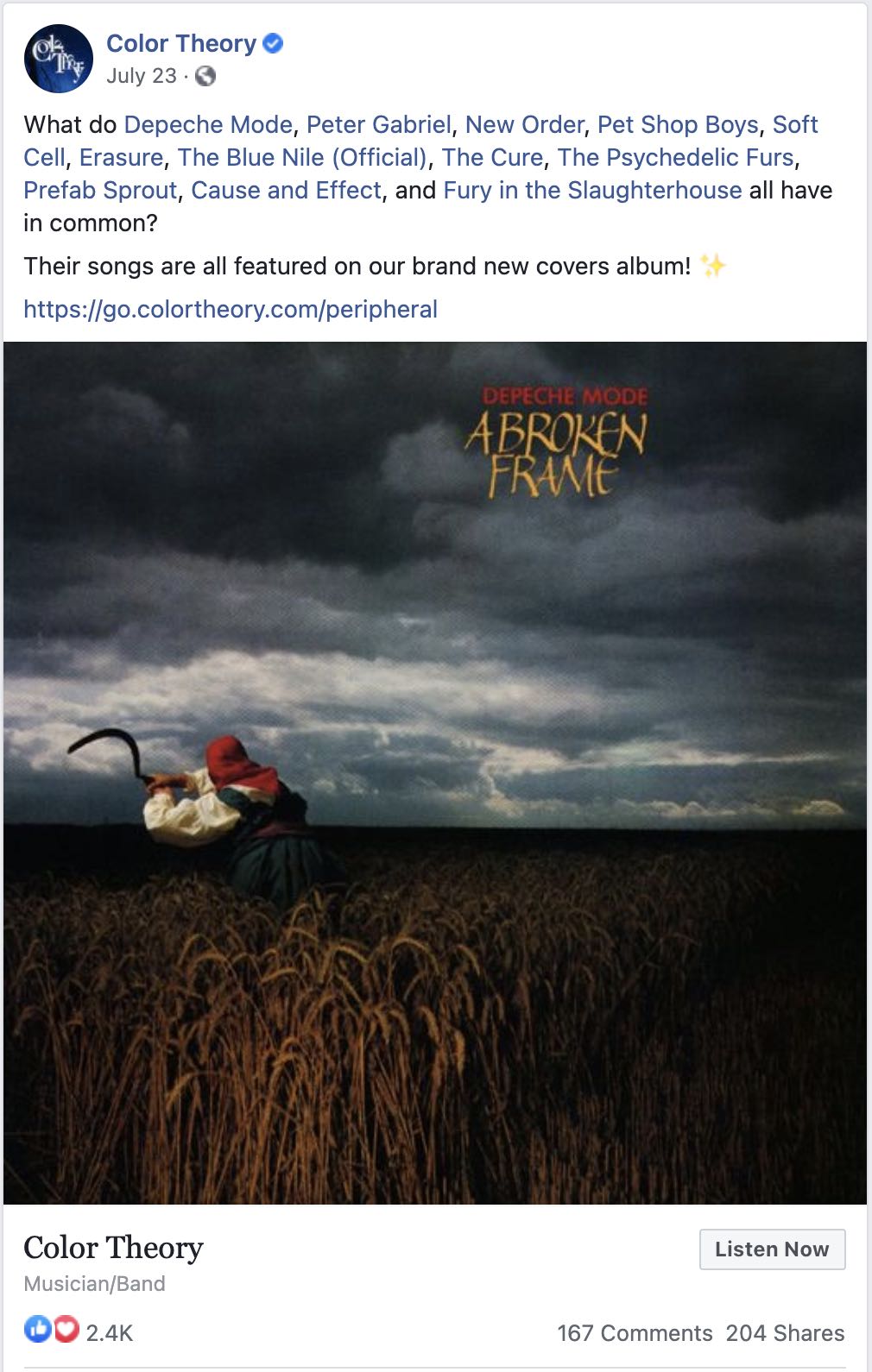
You can see that it got a healthy amount of engagement, including 2.4K likes. I use a Chrome extension called Invite post likers for Facebook to invite everyone who liked the post to like my page, resulting in hundreds of new page followers.
Here are the full stats on that post:
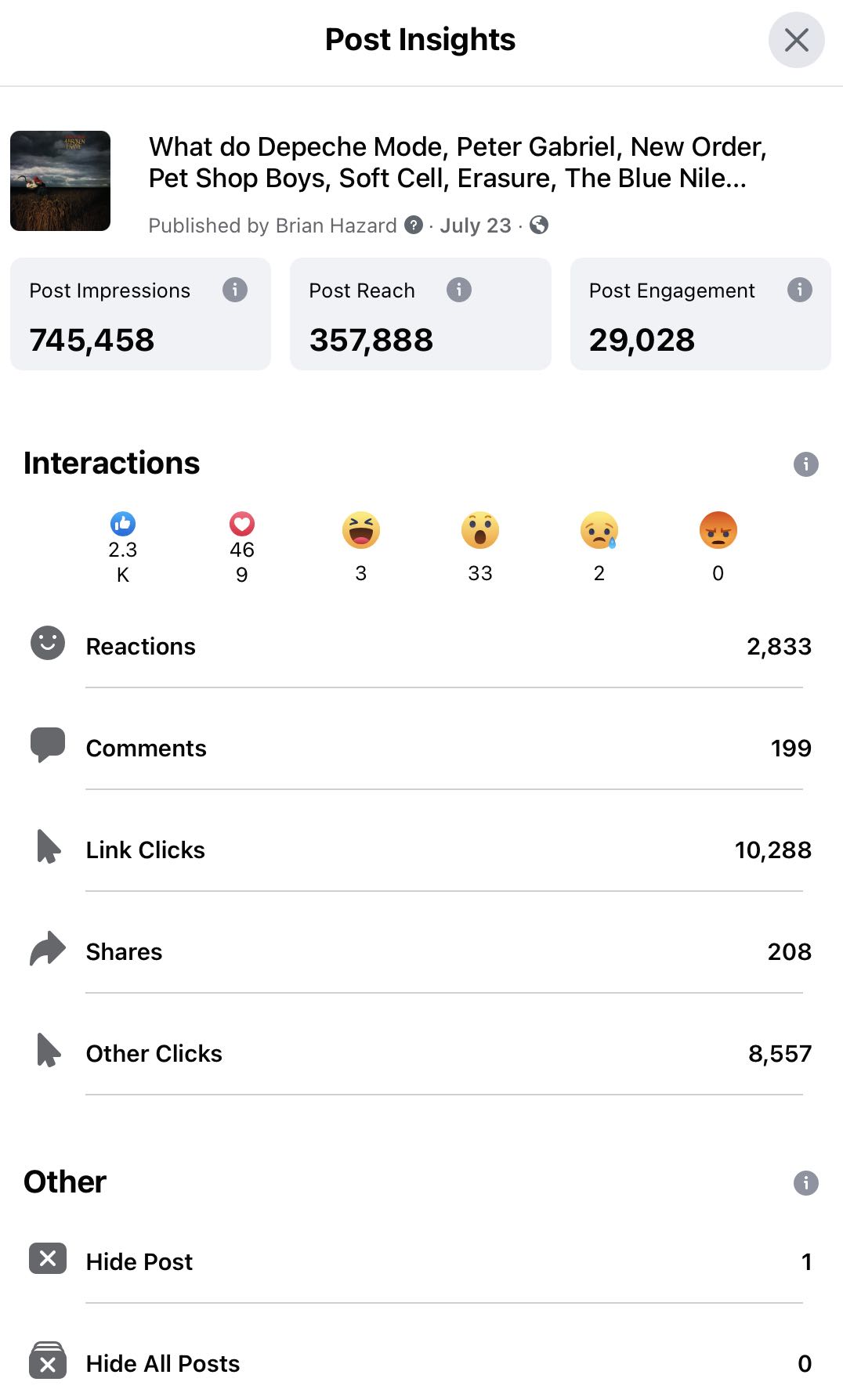
The six video ads and page post were part of a conversions campaign directing to a ToneDen smart link, with a click to Spotify qualifying as a conversion. Total spend was $948.
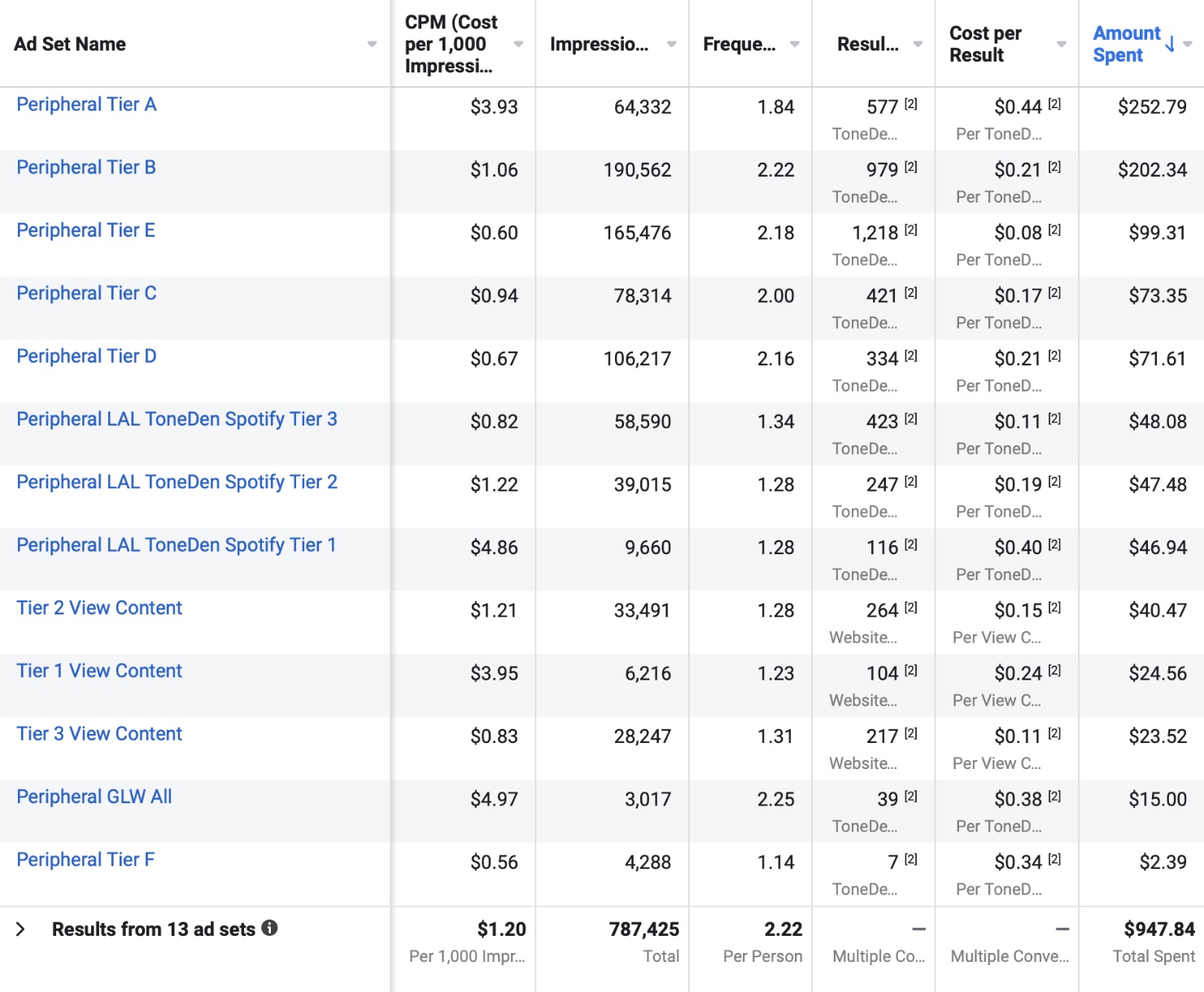
I split the countries up into different tiers to make sure I wasn’t just promoting to India. You can see that the cost per 1000 impressions is highest for Tier A (USA, UK, Sweden, etc) and decreases all the way to Tier F, which is literally just India.
I’m still in the process of perfecting my tier split, and plan to write a dedicated post about it soon!
I turned off the ad campaign a month and four days after release, when my new single came out. Total clicks to Spotify = 5K.
Results and Conclusions
Bandcamp sales total $1560 to date.
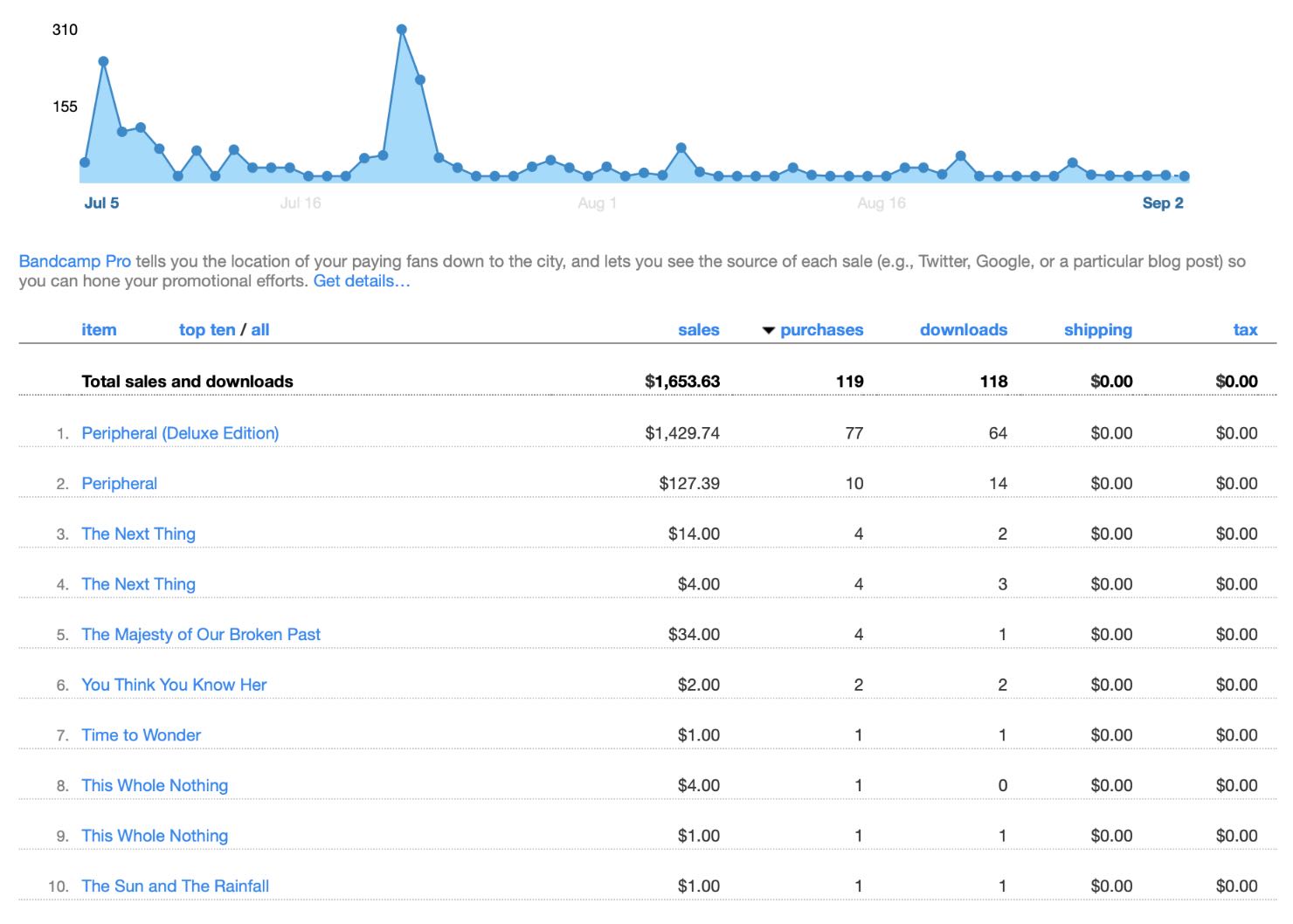
After Bandcamp’s 15%, that’s $1325. I paid mechanical royalties for 100 units via Easy Song Licensing (tell them I sent you!) for $300, leaving us $1025 net.
Facebook ads amounted to $1080, so we more or less broke even, which was the plan. Eventually those fractions of pennies from Spotify will put us back in the black.
Spotify for Artists reports 58K streams since 2015, but that’s deceptive because it includes the streams from tracks that were previously released as singles.
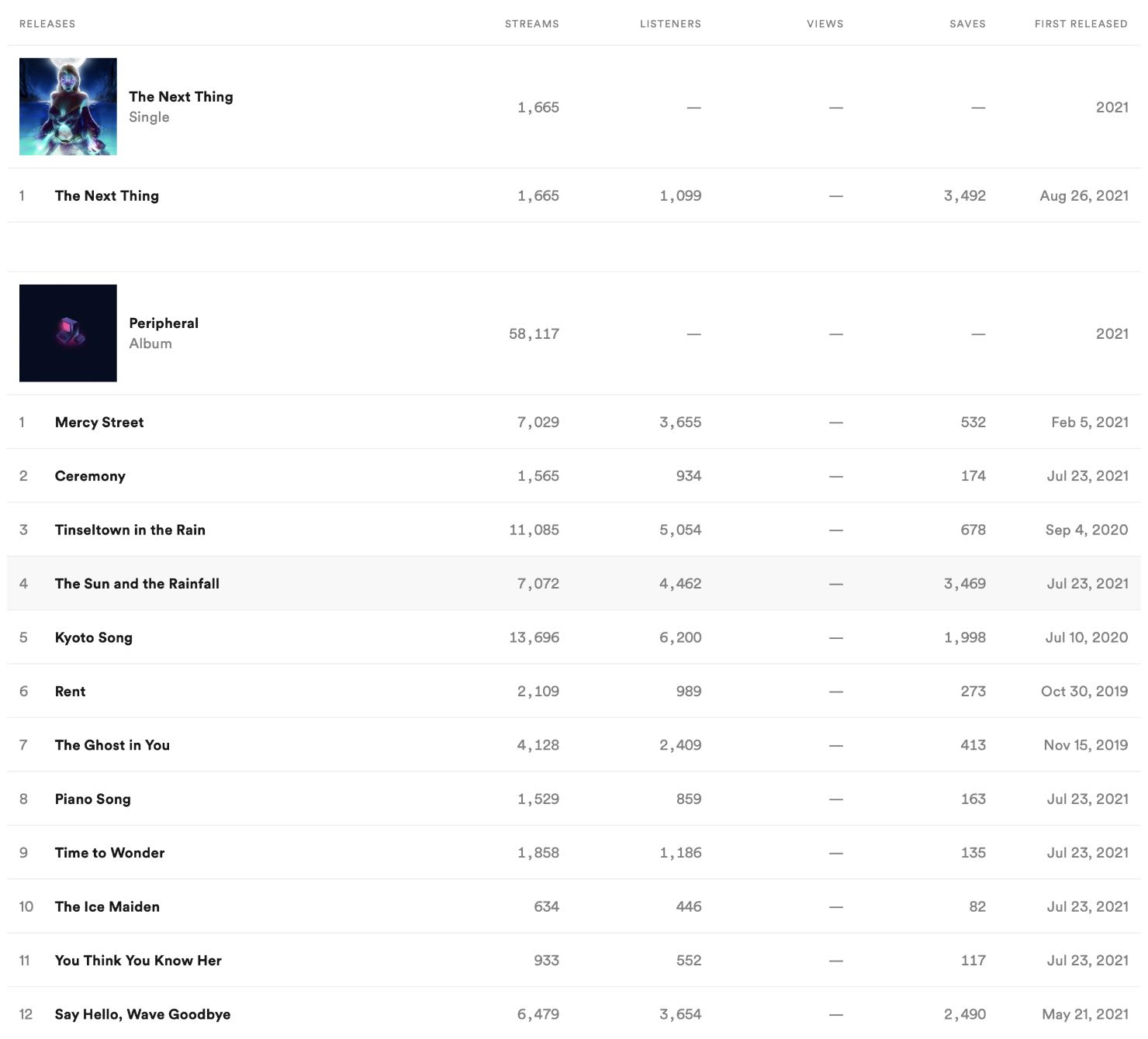
I’m seeing 14K streams in the past 28 days, at 42 days post-release. So maybe 20K streams since release? I should’ve kept track.
You may have spotted the insane number of saves on some of the tracks, particularly my new single which as more than twice as many saves than streams!
That’s thanks to a service called Rise that I’ve been planning to write about for quite awhile now. I’ve been paying $225 a month since May and have accrued 3.6K new Spotify followers through them, all of whom automatically presave each new release.
I still have unanswered questions about the service’s inner workings, but for now I feel confident recommending them for a Spotify conversions campaign – not an exposure campaign. If you try them out, please comment here with your results!
Release Radar is sharing most of the tracks, including a few that were previously released as singles. We haven’t done anything special to promote “Time to Wonder” but it appears to be taking off on its own.
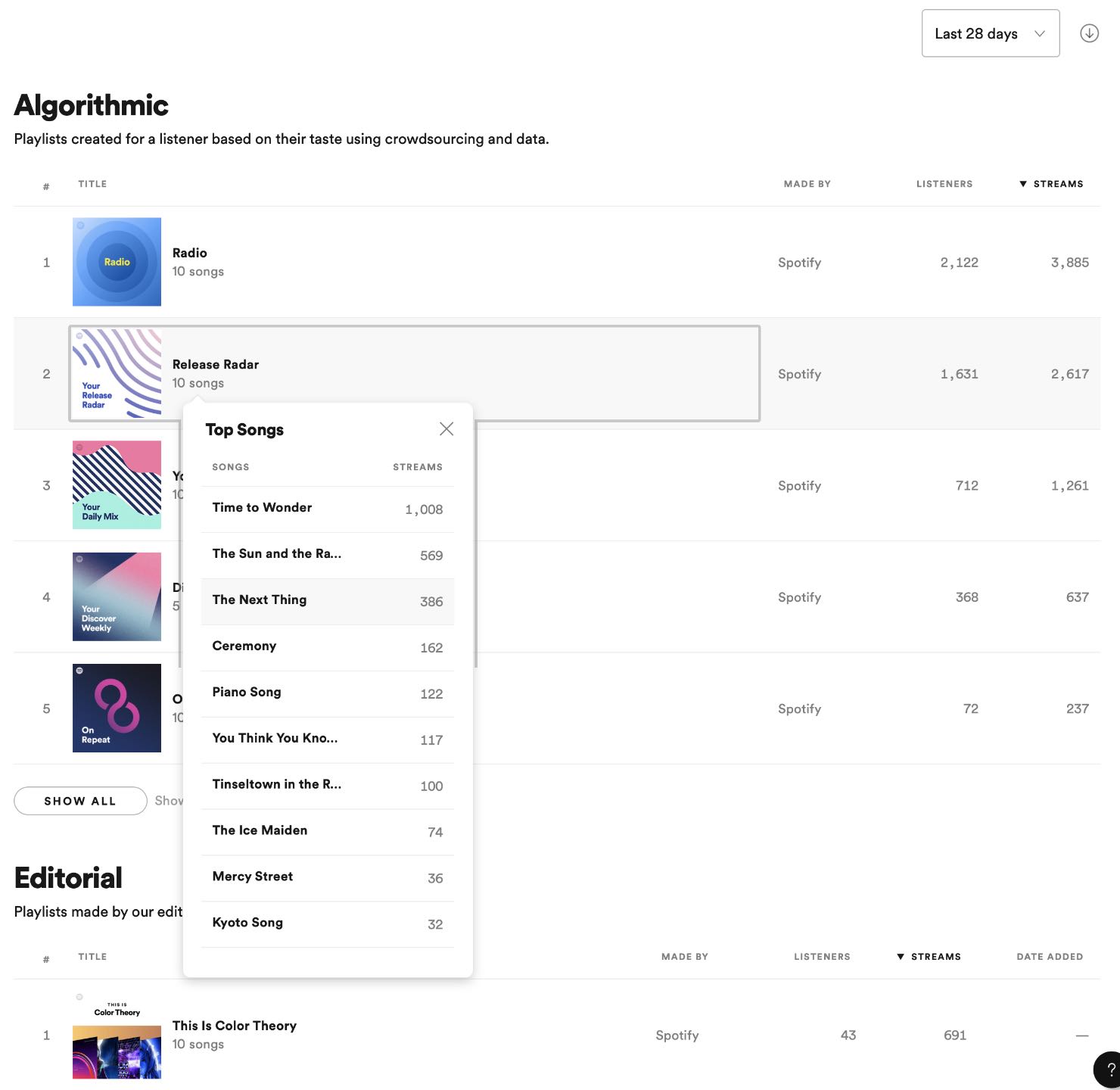
While the ad campaign is over, I’ve still got some loose ends to tie up with the promotion. I’m slowly releasing the tracks on YouTube and SoundCloud to keep the momentum going.
Speaking of which, the days of uploading a cover on YouTube and seeing it go viral are over. I find it much easier to promote originals!
Did I miss anything? Let me know what I could do better in the comments!



Hi Brian – I love these covers and I always learn from your posts. But…in this one you seem to be saying that you don’t have to “pay for the rights” if you release digital only? (“As much as we would’ve loved pressing CDs or even vinyl, paying for the rights doubles the cost.”) It’s my understanding that you do still need to get a mechanical license for a song even if you only plan to release it digitally. You can license a song through the Harry Fox Agency – 1000 digital downloads or physical sales for $91. If I misunderstood your post or you know something different, let me know. Thanks!
Sorry if the opening was deceptive Robin! I just updated the wording to make it more clear. Thanks for pointing that out!
I explain towards the end that I paid $300 for the rights to 100 album downloads through Easy Song Licensing.
The issue with pressing CDs is that 1000 units is the effective minimum. $91 for one song would be manageable, but we’ve got a dozen tracks to license, plus once they get past a certain length the cost goes up, plus some of them weren’t available on Harry Fox’s site through Songfile, so I had to use Easy Song Licensing, which raises the cost again.
Ultimately it would’ve been just shy of $2K for the physical rights.
I didn’t know the service called Rise. I am looking forward to reading more about in your next blog post. By the way, thank you for the awesome job you do on a monthly basis. It’s much appreciated.
You’re welcome Paco! I don’t think Rise will be my next post, but hopefully I can get enough info to write a meaningful review soon.
Nice post Brian, as usual. I reckon it’s the underwear line that had the biggest effect 😉
Maybe one day do a post explaining how musicians can pay for all this promotion by legitimately reclaiming back at tax time etc.
That’s a great idea Mat! I do my taxes myself and report everything, so it could make for a nice case study. My only worry is that I could get in trouble for giving tax advice, even if I say it’s not meant to be taken as tax advice. Plus, it would mostly only apply to US readers.
Ooooh that would be ace, Maybe put the disclaimer in all CAPS at the top of the post.
Yep maybe look into a disclaimer the way financial columns in newspapers always do it. “This is general advice only etc.” I claim back on tax here in Australia any music software and hardware I buy throughout the year, so I think it works in a similar way in other countries.
Music software and hardware is likely an acceptable deduction worldwide. When you get into home office deductions, things start to become more nuanced!
Another great post! Thanks Brian!
You’re welcome! Thanks for the comment!
Brilliant post Brian. So from what I can gather from this you had 2 targets. 1 was the Spotify links and the other was the Bandcamp links. From what I can see the Bandcamp targets tier view content 1,2 and 3 generated all the income with the. Income from Spotify to come. If that is correct then why do the Tone Den Spotify links? Unless I am misreading what happened. I don’t think people went to Spotify and then went to Bandcamp but they went to Bandcamp from the outset. Still a very good effort. The other thing I noticed was that 700,000 impressions resulted in 5000 new Spotify streams. Is that a fair reflection? My advertising approach is evolving and I think garnering new followers on Twitter or any platform that gives you 1 to 1 exposure to all your fans is the way to go. Grow your fans and advertise to them for free. Or bear in mind their platform tax. Still thanks for your hard work and I’ll check out the covers album. Mind you no Tears for Fears or A-ha??? You’re missing a trick there haha
Great to hear from you Kehinde!
For the record, I covered a-ha’s “Living a Boy’s Adventure Tale” on my album The Sound. 🙂
You are correct that the majority of sales happened in the pre-release period, mostly from fans on my email list that I didn’t have to pay to reach. If we just wanted to maximize our income, we could’ve stopped there, but our goal was to maximize listenership.
The post-release campaign generated 5K clicks to Spotify. Presumably each of those clicks resulted in multiple streams because I estimated the stream count at 20K. I wasn’t keeping track so I only had my 28-day count to go by (14K streams in 28 days probably meant around 20K streams in 42 days).
I’ve already got over 2M followers on Twitter, and believe me, that’s not the way to go. My 4.5K Instagram followers are more engaged. Even then, my email list is worth my entire social media presence 10x over. Email subscribers are interested in hearing about your new release. Most social media followers aren’t.
Oh yes email list growth is part of my promotional equation. I am basically going to be tracking each method. Find out what the CTR to Spotify views, physicals and downloads are. Thanks for your reply by the way and don’t forget I heard about you from your Facebook ad for Living A Boy’s Adventure Tale. Also check out http://www.diggersfactory.com for vinyl. I think a vinyl release of covers could yield great results for you. The website also sells to shops as well so potential more sales. CD minimums are 300 not 1000 so potentially might cost a lot less in terms of licensing. Would you consider doing a free CD limited release like you did last year.
I didn’t realize you discovered me through an ad. Yay ads!
I’ll check out Diggers Factory for sure, for my next album. Even the standard edition of our covers album is too long for vinyl at 62 minutes.
IMHO ordering less than 1000 CDs doesn’t make sense on a cost-per-unit basis. It’s only a couple hundred bucks more than 300 units. If I were competent at graphic design, that still might work, but to hire a designer for only 300 CDs? Eh.
Yep and I wrote about you on my blog in 2010 after discovering your music. Here is the article haha. I hear you on the CD front though I am sure you can repress. I am doing a release through Diggers Factory but the delay due to the pandemic is massive. So that is a bit of a pain. I will also look into the CDs as well. I think the main thing is getting the cost of advertising down. Have you seen this guy’s video? Maybe you should set up a Facebook ad agency haha. You probably are already too busy to do that. Happy Fathers Day if it is over in America but also have a great weekend.
I think I remember that post! Thanks again. 🙂
Yeah, I’ve heard about the delays, which is why I’m trying to get on top of it now. I haven’t announced my next album yet, and I want to make a decision on vinyl before I do!
Yep, I’m familiar with Andrew’s channel and we chat from time to time. As for that Facebook ad agency, never say never, but as long as I’m willing and able to make music, that’ll be my number one.
Thanks for the great and very informative post Brian! And the album is fabulous too! I had not heard of Rise before and I see from your response to a question above that you’re not planning on writing about it in the short term. But am I right in understanding from your post that you would recommend their services for a single/album promotion campaign but not necessarily for general artist promotion? A few months ago I finished a fairly lengthy release cycle and was thinking of running a little campaign to keep my artist profile ticking over before I start on the next releases. Do you think they’d be a good bet? Toneden worked brilliantly for me last year but since then, the results haven’t been so great and I can’t quite work out why so I’m looking to change things up a bit. Thanks!
Actually, I’d very much recommend them for ongoing promotion. That’s what I’m doing!
I’m subscribed to their $250/month conversion campaign, which goes down to $225 with the subscription. As of today, it’s gotten me 3700 new Spotify followers at a much lower cost than running my own ads.
Full disclosure: they have a referral program which I signed up for, so if you give them a try please use my link!
Hi Brian, I have signed up and I used the link from your email reply rather than this so it’s possible the referral didn’t work. Is there any way you can check your end? I’ll email them as well. Best!
I see clicks but no referral, so if you could check with Theo at [email protected], I’d appreciate it! He’s the guy you’ll want to email with your Spotify URI whenever you have a new release.
Ah sorry I messed that up! I’ll email Theo.
Thanks! You may have used the right one and the system just didn’t register it yet.
Once again well done Brian! I am in awe of how relentlessly innovative and hardworking you are with your releases and you deserve every success. I am just plain overwhelmed (still) and stagnant. As such, ! I too have emailed Theo at Rise to find out more and mentioned you as the referral.
Wishing you continuing success in huge amounts!
Onwards and upwards!
Thanks Paula! Please keep us posted on your Rise experience! Maybe if a few of you try them out, I can include your results in the article if/when it ever happens.
Hello Brian,
Thank you for the very informative post! I appreciate the time you put in.
I have a question about the Rise service. I used something similar around 3 years ago and I noticed that the only thing I got from that promotion were followers and it didn’t really turn into any real bump in listeners and streams. I’ve watched Rise’s promotional video and their offer and this kinda seems like the exact same deal. They promise you genuine followers but not streams or listeners, which is not the same thing. It seems almost like a “buying followers” scheme.
I can see that they also guarantee that each follower will pre-save your track and agree to pre-saving all of your future releases. It just seems too good to be true. If you think about it, who would agree to something like this, especially if we’re talking about a cold audience? I definitely wouldn’t.
Also, the cost per Spotify follower (as low as 0.83$) seems insanely high. With FB ads I’m getting followers at below .40 cents. Followers that do turn into listeners and streams.
I’m not saying they’re not legit, but I’m definitely curious to know why you think they are. The 3.6k followers you got from their campaigns seems like a huge number, but did it translate into listeners and streams? And how could you even calculate that properly since you were running your own ads at the same time?
Thank you in advance for your reply!
These are exactly the concerns I’m trying to address before writing about Rise.
The way it works is, your music is served to users who opted into receiving recommendations through a Messenger bot. Listeners who like it grant permissions to their Spotify profile, just like if they were pre-saving a track. They may be cold audiences to us as the artist, but they’re warm to Rise.
I know that’s all legit, because I’ve tried it myself from the other end. As for whether it amounts to listeners and streams beyond the initial opt-in, I really can’t say. I have no way to isolate Rise traffic from the rest, between my own ads, playlists, and algorithmic streams. I see the saves in Spotify for Artists, and even theorized that more saves than listeners might actually be a red flag for Spotify, but I’m assured that’s not the case.
As for the cost per follower, I believe I’ve paid much less than $0.83. The question is, where are these followers? If they’re predominantly US, that’s a bargain.
At some point I’ll nag them again, but I don’t think they’re open to sharing the inner workings of the platform. My best guess is that it works exactly as I described, and that I’m not seeing huge results because people who opted in have their Spotify profiles loaded to the gills with crap that was added by the bot.
Oh, one more bonus! I’m getting about 1.5K streams per month from their themed playlists, like Relax & De-Stress.
Is it better than Toneden?
Apples and oranges. Right now I’m using Rise alongside an ads campaign directing to a ToneDen landing page.
Hello when you promoted your digital album directly to cold traffic to bandcamp spending $127 getting 1,606 link clicks how many customers did you get to buy your digital album and how much in sales did you get?
Because Bandcamp doesn’t support Facebook’s pixel, I have no way to distinguish sales from ads versus sales from my mailing list or social media. In other words, I have no idea!